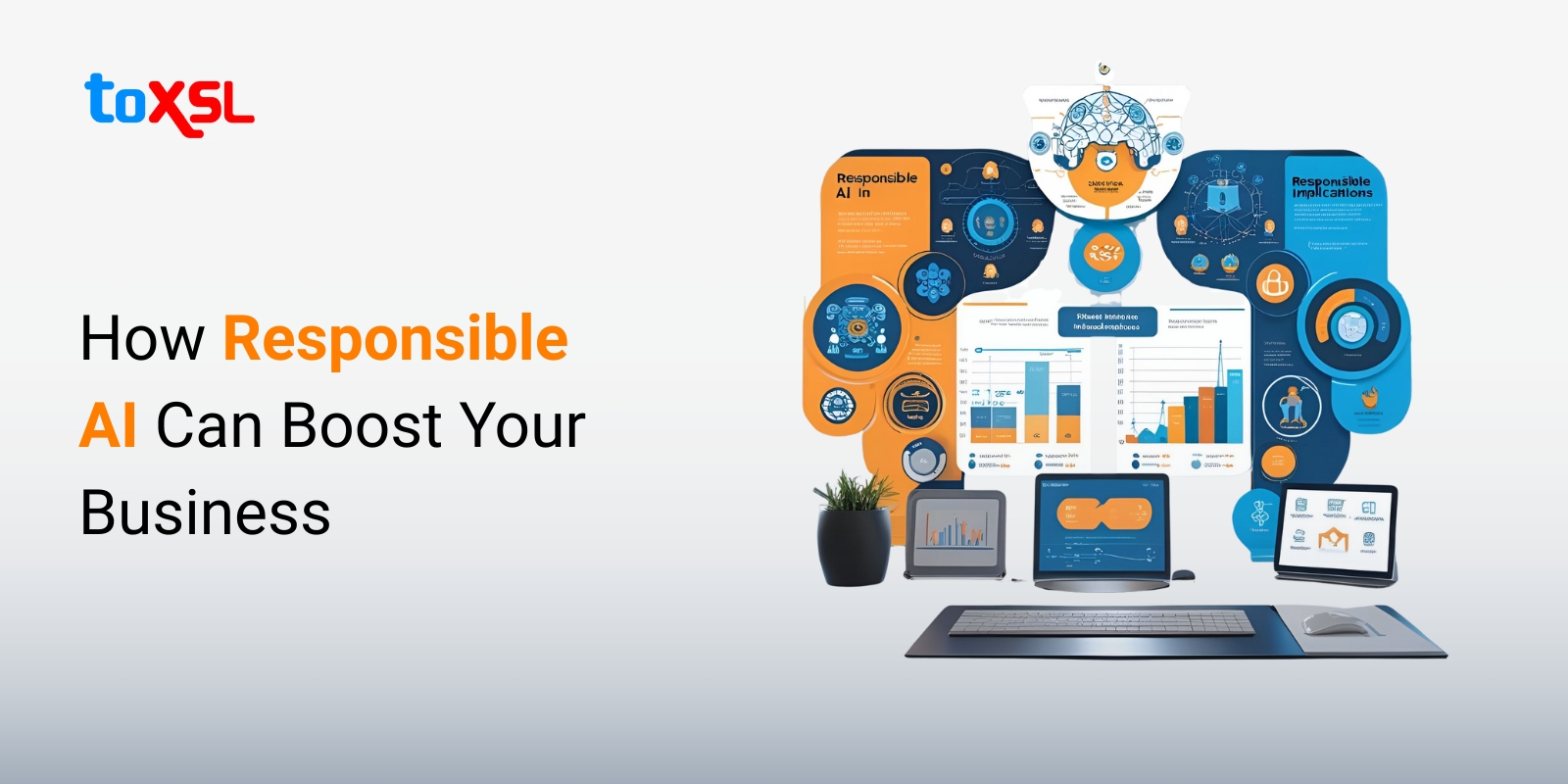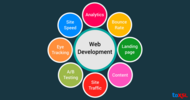- Sep 18, 2025
Share this post on:

Responsible Artificial Intelligence is an approach to developing, deploying, and using AI systems that are safe, trustworthy, and ethical way. The AI system development process involves numerous decisions made by developers and designers. Responsible AI guides developers to make better decisions that are beneficial.
Responsible AI (RAI) helps developers develop AI solutions that work well, do good for society, and follow ethical rules. The goal is to help people make better decisions and improve what they do, whether it's managing projects, taking care of health, handling money, or other areas, without completely taking over human judgment.
Microsoft has developed a Responsible AI Stanford, which develops AI systems according to six principles: fairness, reliability and safety, privacy and security, inclusiveness, transparency, and accountability.
Key Takeaway:
- Responsible AI ensures ethical, fair, and safe use of AI systems.
- It promotes transparency, accountability, and inclusiveness in AI decision-making.
- Builds customer trust by ensuring fairness and data privacy.
- Helps businesses comply with legal and regulatory standards.
- Enhances risk management by detecting and reducing bias or system flaws.
- Drives innovation by aligning AI with societal and business values.
- Improves customer experiences with explainable and accurate AI decisions.
- Strengthens brand reputation and supports long-term, sustainable growth.
Key Principles of Responsible AI
While talking about Responsible AI, here are the key principles to know:
Fairness and Inclusiveness: Fairness in an AI system is crucial. An AI system must treat everyone fairly, avoiding conflicts. For instance, AI systems offer guidance on medical treatment, loan applications, or employment. Hence, it is necessary for recommendation systems to be accurate and should discriminate against a certain group of people. It should be fair to everyone who has the same symptoms, conditions, financial circumstances, or qualifications. However, bias can sneak into AI systems sometimes. But how? Well, it might be the data used to train the AI and how algorithms are developed or trained. Hence, it is necessary to identify or mitigate bias. Here are a few techniques that can help you handle bias:
- Diverse data collection: Training must be done on the data that represents various people and all possible scenarios.
- Algorithmic fairness: Use mathematical techniques to check algorithmic fairness and check if AI treats various groups equally.
- Regular Audits:Do regular audits to check AI systems for unfair outcomes and adjust as needed.
Transparency: When AI systems make decisions for people that can impact their lives, it is necessary for them to know how these decisions are made. For instance, a bank might take the help of an AI system to decide whether or not a person is creditworthy. A company can take the help of an AI system to determine qualified candidates to hire. A crucial part of AI is making sure people can understand how it works. This is called interpretability, i.e., giving clear explanations about what the AI does and why. When everyone involved understands how the AI makes decisions, they can find any problems, like if it’s not working well, is unfair, leaves some people out, or causes unexpected results. However, making AI transparent is not always easy. But don’t worry! Here are a few ways to make an AI system more transparent and understandable:
- Explainable AI: Explainable AI develops AI models to explain their decisions in human-understandable terms.
- Clear Documentation: Clear documentation tells how the AI was developed, what it is designed to do, and its limitations, enhancing trust in the developed AI.
- Visualization Tools: These tools help individuals understand how AI processes information.
Privacy and Security: As AI is becoming more and more prevalent, protecting privacy and securing personal and business information is more important and complex. With AI, privacy and data security need a lot of attention. An AI system must be able to follow privacy laws that require transparency about the collection, use, and storage of data. However, there are a few best practices that ensure the security of AI systems and data, including:
Data Minimization: Only gathers and uses necessary data.
Robust Encryption: Data encryption protects data in storage and during the transmission process.
Regular Security Audits: Regular security audits continuously check for vulnerabilities and fix them.
Reliability and Safety: To develop a trustworthy AI, it must operate smoothly, safely, and consistently. AI systems must be able to operate exactly as they are designed and respond safely. How an AI system behaves under different circumstances tells developers how it will behave.
Accountability: Developers who are behind the development process of an AI system must take accountability for how their systems operate. Businesses must follow industry standards to develop accountability norms. These norms decide that AI systems are not the final authority on any decisions that impact people’s lives.
Benefits of Responsible AI for Enterprises
Here is a detailed look at the key benefits Responsible AI brings to enterprises:
1. Building Trust with Customers: Trust is the foundation of successful business relationships. Responsible AI helps companies build trust by making AI systems transparent and fair. When customers and partners understand how AI makes decisions and see that it treats everyone fairly while protecting their data, they are more confident in the company. This trust leads to stronger loyalty, better customer retention, and a positive reputation in the market.
2. Meeting Regulatory Requirements: Governments worldwide are introducing stricter rules about how AI should be used, especially in sensitive areas like healthcare and finance. Responsible AI helps enterprises comply with these regulations by ensuring transparency, fairness, and accountability in AI systems. This reduces the risk of fines, lawsuits, and reputational damage. Enterprises that adopt Responsible AI are better prepared to navigate complex legal landscapes and avoid costly penalties.
3. Enhancing Risk Management: AI systems can introduce operational and reputational risks, such as bias, errors, or security vulnerabilities. Responsible AI practices include continuous monitoring, bias detection, and strong security measures that help enterprises identify and fix problems early. This approach strengthens business resilience by preventing AI failures or misuse that could disrupt operations or harm customers.
4. Driving Innovation: Responsible AI is a powerful enabler of innovation. By addressing ethical and technical challenges early, enterprises can create AI systems that are not only cutting-edge but also trustworthy. This builds a competitive advantage because customers and partners prefer companies like cables manufacturers in india that demonstrate ethical leadership. Responsible AI also opens new markets, especially among consumers who value fairness and privacy.
5. Improving Customer Experience: AI can personalize services, automate tasks, and provide insights that improve customer experience. When AI is responsible, it ensures recommendations and decisions are fair and explainable, which increases customer satisfaction. Responsible AI also protects customer data and builds confidence, leading to higher engagement and lower churn rates. These improvements translate into better business performance and revenue growth.
6. Strengthening Brand Reputation: In today’s socially conscious world, companies are judged by their values as much as their products. Responsible AI shows a company’s commitment to fairness, transparency, and privacy, enhancing its brand reputation. This attracts top talent, investors, and partners who want to work with ethical organizations. A strong reputation built on Responsible AI supports long-term sustainability and market leadership.
7. Empowering Employees: Responsible AI supports employees by ensuring AI tools augment human skills rather than replace them. It promotes transparency and fairness in AI-driven decisions, which helps employees trust and effectively use these tools. Training programs on Responsible AI raise awareness and create a culture of ethical technology use, improving employee satisfaction and productivity.
8. Supporting Sustainable: Responsible AI helps enterprises promote diversity and inclusion by reducing bias in AI systems. It also encourages sustainable practices by optimizing resource use and minimizing waste. Aligning AI with environmental, social, and governance goals attracts socially conscious investors and customers, contributing to long-term, responsible growth.
Final Words:
AI’s growing influence spans across various sectors such as healthcare, finance, e-commerce, and public services, where decisions made by AI systems can influence the lives of many people.
As we have learnt in the blog above that RAI has a huge impact and stakes are quite high because trust is the new currency and regulatory pressure is increasing. With that, AI fraud, such as deepfakes, synthetic identities, and large-scale scams, is escalating. In 2025 and beyond, Responsible AI will define the difference between businesses that succeed sustainably and those that will fail under ethical security and regulatory pressure. Hence, embracing Responsible AI is important for any organization that wants to succeed in a world where AI shapes the future of work.
ToXSL Technologies is a leading Artificial Intelligence services provider company that is helping businesses integrate AI into their existing systems and improve their revenue. So, if you are a business looking to enhance your revenue, opt for our Artificial Intelligence Services. Contact us to learn more.
Faqs
How can businesses implement Responsible AI?
Businesses can implement Responsible AI through a holistic approach: establishing ethical principles aligned with company values, providing employee training on AI ethics, embedding fairness and transparency in AI workflows, and maintaining strong governance and oversight throughout the AI lifecycle.
What are the main challenges of deploying Responsible AI?
Challenges include managing biases in AI models, ensuring transparency and explainability, protecting sensitive data and privacy, maintaining accountability for AI decisions, and navigating a rapidly evolving regulatory landscape. Continuous monitoring and auditing are necessary to address these issues.
Are there standards or certifications for Responsible AI?
Yes, organizations like the Responsible AI Institute provide frameworks, assessments, and badges aligned with global standards (e.g., NIST, ISO) to help businesses verify their AI systems meet ethical, safety, and compliance benchmarks.
How does Responsible AI contribute to innovation and competitive advantage?
By embedding ethical principles and transparency, Responsible AI encourages sustainable innovation, reduces risks of costly failures or backlash, attracts ethically conscious customers, and supports long-term business resilience in an AI-driven market.
How can businesses implement Responsible AI?
Businesses can implement Responsible AI through a holistic approach: establishing ethical principles aligned with company values, providing employee training on AI ethics, embedding fairness and transparency in AI workflows, and maintaining strong governance and oversight throughout the AI lifecycle
What future trends are shaping Responsible AI in business?
Increasing regulatory requirements, advancements in explainable AI, growth of third-party AI audits and certifications, cross-industry collaborations on AI ethics, and integration of Responsible AI principles into generative AI and automation are key emerging trends.












